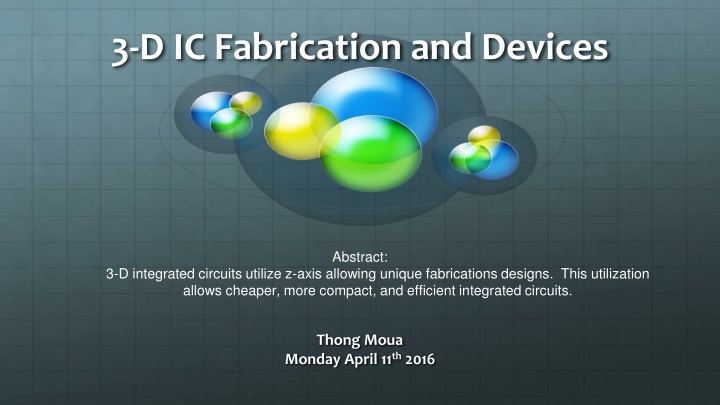
Innovative 3D IC Fabrication Techniques for Compact Integrated Circuits
Explore the world of 3-D integrated circuits (ICs) that leverage the z-axis for unique designs, enabling cost-effective, compact, and efficient ICs. Learn about fabrication methods, benefits, issues, current technology, and applications in this cutting-edge field.
Uploaded on | 2 Views
Download Presentation

Please find below an Image/Link to download the presentation.
The content on the website is provided AS IS for your information and personal use only. It may not be sold, licensed, or shared on other websites without obtaining consent from the author. If you encounter any issues during the download, it is possible that the publisher has removed the file from their server.
You are allowed to download the files provided on this website for personal or commercial use, subject to the condition that they are used lawfully. All files are the property of their respective owners.
The content on the website is provided AS IS for your information and personal use only. It may not be sold, licensed, or shared on other websites without obtaining consent from the author.
E N D
Presentation Transcript
3-D IC Fabrication and Devices Abstract: 3-D integrated circuits utilize z-axis allowing unique fabrications designs. This utilization allows cheaper, more compact, and efficient integrated circuits. Thong Moua Monday April 11th2016
Outline Background information Introduction to 3D IC Fabrication Benefits/issues Current technology Applications
Background info How integrated circuits are made Silicon ingot is grown Sliced into wafers Chip design is etched on Wafer is diced according to chip
Introduction to 3-D ICs A Single Circuit with two or more layers of active components connected by TVS Utilizes the z-directional axis to improve performance, reduce power, etc.
Four main types of Fabrication Monolithic Wafer-on-Wafer Die-On-Wafer Die-On-Die
Fabrication (Wafer-on-Wafer) Components are built on two or more wafers Wafers are aligned accordingly Bonding of the two wafers Thinning of wafers (can be done before or after bonding) Wafer is diced
Benefits of 3D IC Lower fabrication cost Save space Allows for miniaturization Improved performance Better bandwidth Reduced power
Issues with 3D IC Yield Heat Design complexity Testing Lack of standards
SIP (system in packaging) SiP is multiple bare dice and/or chips mounted on a common substrate, which is used to connect them all together. Packaged together.
2.5D integrated Circuits Package-on-Package (PoP)
Applications True 3d IC is still in need of further research and development. Monolithic IC 3D inc. 3D Logic 3D memory 3D electro optics DRAM (Intel and micron hybrid memory cube)
Conclusion 3-D integrated circuits is the next step in increasing performance of our technology. Its unique design in the z-axis allows for profound benefits, but at a cost of heat, complexity, etc. However further research and development can minimize the cons and allow a more commercialized product.
References http://www.extremetech.com/computing/197720-beyond-ddr4-understand-the-differences-between- wide-io-hbm-and-hybrid-memory-cube http://www.monolithic3d.com http://www.invensas.com/Company/Documents/Invensas_IPCAPEX2013_3D.pdf http://www.eetimes.com/document.asp?doc_id=1279540 http://www.xilinx.com/programmable/about/research-labs/3-D_Architectures.pdf https://en.wikipedia.org/wiki/Three-dimensional_integrated_circuit All Images provided by Google
5 key concepts 3D IC is a integrated circuit by stacking wafers/dies so they behave as one single device. Four main types of fabrication; Monolithic, Wafer-on-Wafer, Die-on- Wafer, Die-on-Die Benefits of 3D IC Issues of 3D IC Applications; HMC and Vertex-7 2000t
